Posts Tagged ‘qaf eurokars’
The hardest is to admit
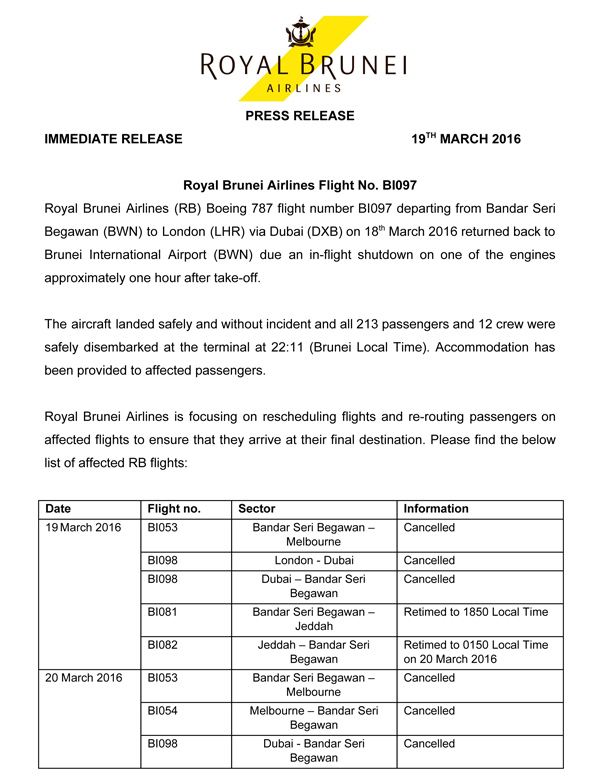

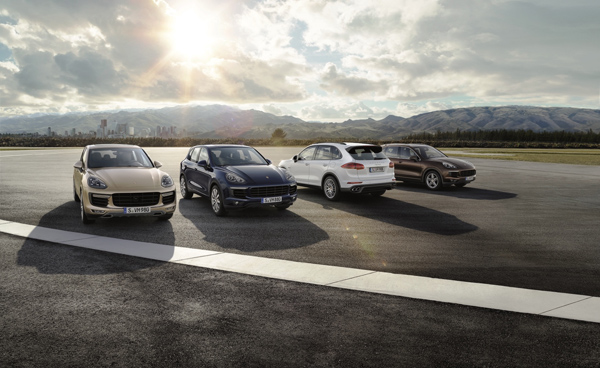
Even more efficient and dynamic: the new Porsche Cayenne
QAF Eurokars Sdn Bhd, the official importer of Porsche vehicles in Brunei, introduce the new Porsche Cayenne models to the Brunei market. A sharper design, boosted efficiency and extensive set of standard features: Those are the key characteristics of the new Porsche Cayenne. As a sports car among sport utility vehicles (SUVs), besides offering five seats and extensive high-end features, it primarily offers a lot of room for a lot of driving fun. With high performance and typical Porsche design DNA.
The new generation of the Cayenne will launch on the market: namely the Cayenne, Cayenne S, Cayenne Diesel, and the top-of-the-line Cayenne Turbo S. All Cayenne engine versions show improved performance figures as well as better fuel economy than comparable previous versions. A new engine is the 3.6-litre V6 biturbo of the Cayenne S that was fully developed by Porsche.
The Cayenne is a unique success story at Porsche. The company introduced the first generation in 2002. This vehicle made the idea of a sports car in the SUV segment a reality – and it set standards right from the start. Sales have exceeded all expectations: Over 276,000 first generation vehicles were produced (2002 to 2010), and around 303,000 units of the second generation, which was introduced in 2010, have already been produced so far. So the Cayenne is not only boosting profitable growth at Porsche, it is also creating a solid economic foundation for investments in future generations of sports cars.
Sharpened exterior design
In its latest version, Porsche designers have given the Cayenne an even sharper design with precise lines and purposefully placed light refracting edges. Entirely new are the design of the front body, the front wings and the bonnet. Also new are the airblades: These air fins on the right and left of the vehicle’s front end efficiently guide cooling air to the intercoolers and also make a strong visual statement.
At first glance, the new Cayenne can be clearly made out as a Porsche by its bi-xenon head-lights, which are standard in the base and S models, with “hovering” four-point LED daytime running lights that are typical of Porsche. The high performance standard of the top model, the Cayenne Turbo S, is emphasised by standard LED headlights with the Porsche Dynamic Light System (PDLS).
The rear section of the new Cayenne was also thoroughly updated: the layout of the rear lights creates a three-dimensional effect; the brake lights – like the LED daytime running lights in front – are designed in four elements. The license plate recess, boot handle and lights are now integrated more elegantly into the boot lid. Designers also re-designed the car’s horizontal lines, giving the vehicle an even fuller stance on the road. The newly designed exhaust tailpipes are now integrated in the lower rear section. An automatically activating boot lid is a standard feature.
In the interior, designers devoted much of their effort to the driver’s space – the driver now gets a new multifunction sport steering wheel with shift paddles as standard; its look and functions are based on the steering wheel of the 918 Spyder. They also made the rear seating system even more comfortable, and seat ventilation can now be ordered as an option for the rear seats.
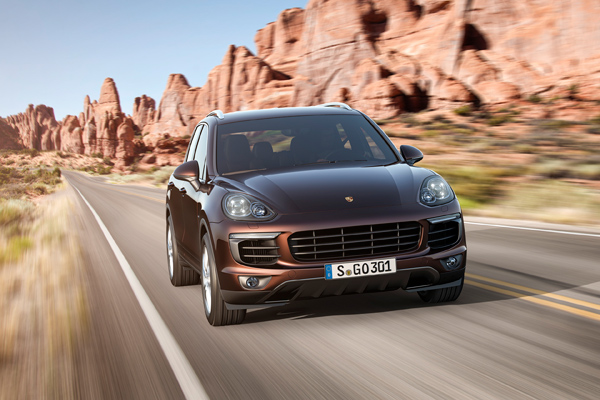
Better efficiency
Power and torque were boosted while improving fuel economy: for Porsche these are not incompatible or contradictory goals; they were enabled by numerous individual modifications to the entire drivetrain. For instance, all new Cayenne models consume significantly less fuel, because of a coasting function, the further advanced “auto stop-start function plus” and optimised thermal management. Active cooling air flaps are now being used for the first time in the Cayenne models. They are located behind the middle air inlet and are controlled by engine management. They are opened or closed according to the specific driving situation and cooling needs; this way they adjust the air volume that is available for cooling. When they are closed they improve aerodynamics, which reduces air drag and thereby improves fuel economy.
The new 3.6-litre V6 biturbo engine of the Cayenne S, which was developed entirely at Porsche, is another example of how downsizing with reduced engine displacement and fewer cylinders does not compromise core values: the engine’s NEDC fuel consumption is between 9.5 and 9.8 l/100 km (223-229 g/km CO2), which is one litre less than with the previous V8 engine. The biturbo V6 develops a maximum power of 420 hp (309 kW) at 6,000 rpm – a gain of 20 hp/15 kW. The car’s torque of 550 Newton metres is available from 1,350 to 4,500 rpm (gain of 50 Newton metres). The previous power density of 83 hp (61 kW) per litre engine displacement was increased to 117 hp (86 kW) (gain of around 40 percent). With its standard eight-speed Tiptronic S transmission, the Cayenne S accelerates from zero to 100 km/h in just 5.5 seconds (5.4 seconds with the optional Sport Chrono package) – 0.4 seconds faster than the previous Cayenne S. The vehicle’s top speed is now 259 km/h (gain of one km/h).
The new Cayenne Turbo S – the top model of the sporty SUV model series. Its re-engineered 4.8- liter V8 biturbo engine now develops 570 hp (419 kW) and 800 Nm (590 ft lb) of torque. A chassis that is tuned for maximum driving dynamics and packs a wide range of control systems also makes the Cayenne Turbo S a genuine top athlete. It can turn a lap of the North Loop of the Nürburgring in 7:59.74 minutes. The Cayenne sets a new record for SUVs here, and it also proves that every Porsche is a genuine sports car – even in this vehicle segment.
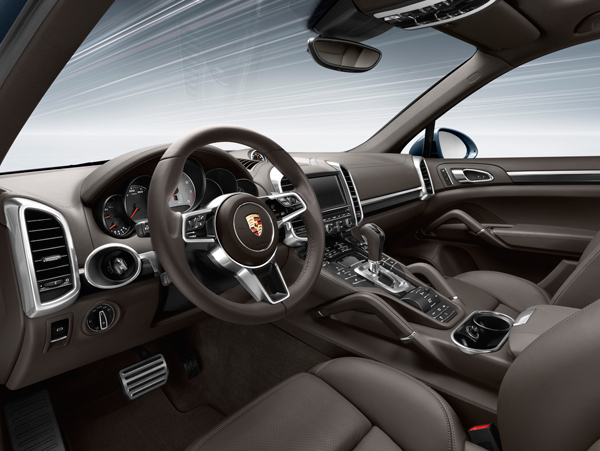
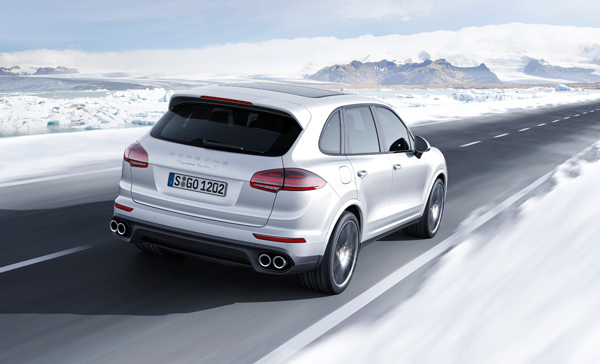
The more spontaneous response of the biturbo engine is primarily a benefit of the integral turbochargers, which are now housed directly in the exhaust manifolds. This new approach also improves combustion. The high-performance engine offers 20 hp more power and 50 Nm (36.8 ft lb) more torque than the previous engine. The Cayenne Turbo S accelerates from zero to 100 km/h in 4.1 seconds – which is 0.4 seconds faster than the previous model (0 – 60 mph in 3.8 seconds). Its top speed is now 284 km/h (176 mph).
The Cayenne Turbo S also underscores its position as a top athlete in its chassis systems. Its standard Porsche Composite Ceramic Brakes (PCCB) include 420 mm front brake discs and, for the first time, ten-piston calipers. The rear brakes have 370 mm discs and four-piston calipers. The active roll stabilization system, Porsche Dynamic Chassis Control (PDCC) proactively reduces side tilt when driving through curves early on. Porsche Torque Vectoring Plus (PTV Plus) increases dynamic handling and stability by making specific brake interventions at the right or left rear wheel – this noticeably improves steering into curves and steering precision. The active hang-on all-wheel drive system Porsche Traction Management (PTM) permanently drives the rear wheels while offering fully variable power distribution to the front wheels. Some advantages of the interplay between all systems: excellent driving dynamics and traction as well as a high level of agility at any speed.
Standard features of the Cayenne Turbo S reflect the top level of this model. They include 21-inch wheels in distinctive 911 Turbo design with black painted edges, LED headlights including Porsche Dynamic Light System Plus (PDLS Plus), full-leather interior with Porsche logo embossed on all head restraints as well as interior carbon accents. Interior styling in a black/creme color combination is making its debut in the Cayenne Turbo S. Creating exterior visual accents are the air inlet surround at the front of the vehicle that is painted in high-gloss black, the undersides of the door mirrors in the same color and the roof spoiler and wheel arch moldings in car color. A sport exhaust system is available as an option in combination with a switchable sound symposer, which optimally transmits the V8 sound experience into the interior.
The diesel versions of the Cayenne combine sportiness with even better fuel efficiency. For example, the three-litre V6 engine in the Cayenne Diesel produces 262 hp (193 kW) at 4,000 rpm and has a fuel consumption of 6.6 to 6.8 l/100 km (173-179 g/km CO2). Thanks to its SCR system, the car already conforms to the EU6 emissions standard. In interplay with its torque of 580 Newton metres, from 1,750 to 2,500 rpm, the car can accelerate from zero to 100 km/h in 7.3 seconds (7.2 seconds with the optional Sport Chrono package), and its top speed is 221 km/h. The 4.2-litre V8 engine of the Cayenne S Diesel produces 385 hp (283 kW) at 3,750 rpm and a torque of 850 Newton metres from 2,000 to 2,750 rpm. From a standstill, it reaches 100 km/h in 5.4 seconds (5.3 seconds with the optional Sport Chrono package). Its top speed is 252 km/h, and its NEDC fuel consumption is 8.0 l/100 km (209 g/km CO2).
Chassis tuning of the new Cayenne was optimised for even greater comfort, naturally without compromising its dynamic pace. This makes the spread between comfort and sportiness even greater than before – and it validates the Cayenne claim to being the sports car in the SUV segment. Press release from QAF Eurokars Sdn Bhd.

Continue Reading Comments Off on The hardest is to admit



